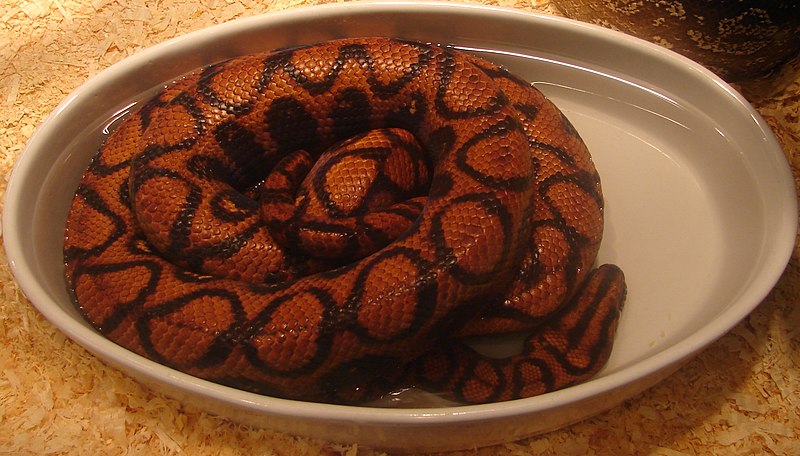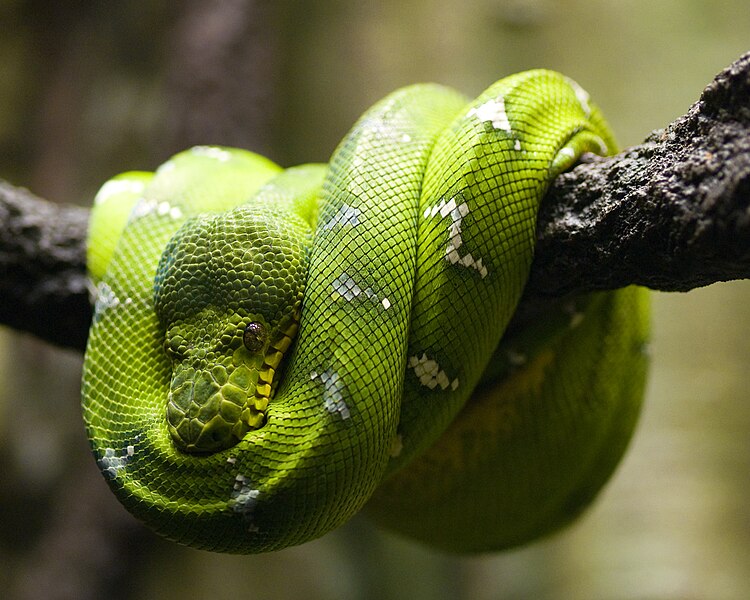 The 53 species in the family Boidae are an amazingly diverse group of snakes that have colonized habitats ranging from rainforests to deserts, in countries as diverse as Canada and India. Among them we find treetop dwellers, aquatic species, confirmed burrowers and generalists equally at home in farmland, savannas, desert fringes and forests. I’ve had the good fortune of studying Anacondas, Rosy Boas and others in the wild, and remain fascinated by all. Please be sure to post some thoughts about your favorites below.
The 53 species in the family Boidae are an amazingly diverse group of snakes that have colonized habitats ranging from rainforests to deserts, in countries as diverse as Canada and India. Among them we find treetop dwellers, aquatic species, confirmed burrowers and generalists equally at home in farmland, savannas, desert fringes and forests. I’ve had the good fortune of studying Anacondas, Rosy Boas and others in the wild, and remain fascinated by all. Please be sure to post some thoughts about your favorites below.
Classification and Terminology
The family Boidae is divided into 3 subfamilies. Most boas are placed in the subfamily Boinae. The ten Sand Boas of southern Europe, Africa and Asia, the Calabar Ground “Python” and North America’s Rubber and Rosy Boas are classified in the subfamily Erycinae. Ungaliophiinae is comprised of the Oaxacan, Isthmian and Panamanian Dwarf Boas.
The term “boa” usually refers to the Common Boa. A short “first name” is applied to others, i.e. Rough-Scaled Boa, Rainbow Boa, Malagasy Tree Boa, Pacific Boa.
Size
Many species average 2-5 feet in length, but the Common Boa Constrictor, can exceed 13 feet in length. The family giant, the Green Anaconda, is also the world’s heaviest snake.
The record-sized Common Boa is said an 18.5 foot specimen killed on Trinidad in 1944. However, a recent investigation into the incident established that an Anaconda, and not a Common Boa, was described in the original account (please see this article for details). The longest individuals I’m aware of were taken in Surinam, and measured 13 feet, 6 inches and 14 feet.
Range
Boas reach their greatest diversity in that portion of the American tropics stretching from central Mexico to Argentina. Rosy Boas range into the southwestern USA; Africa, Asia and the South Pacific are home to numerous others. Two species live in “unexpected” places – the Rubber Boa reaches southern Canada and the Javelin Boa inhabits Greece and the Balkans.
Note: The following information can be applied to many pet trade species. However, details will vary. Please see my species-specific articles and also post a comment below if you would like further information.
Behavior
 Rosy and Common Boas vary widely in personality, with many being calm and well-suited to captive life, while arboreal species may remain high-strung and “snappy”.
Rosy and Common Boas vary widely in personality, with many being calm and well-suited to captive life, while arboreal species may remain high-strung and “snappy”.
Boas are not domesticated animals and must never be handled carelessly, as even long-term pets may react to scents or vibrations that people do not perceive. Bite wounds can be severe. Two experienced adults should always be on hand when specimens over 6 feet in length are fed, cleaned or moved.
Housing
Setting up the Terrarium
Hatchlings may be started-off in 10 gallon aquariums. Larger species usually require custom-built cages, but some, such as Sand, Dwarf and Rosy Boas, can be accommodated in a 30-55 gallon tank. The screen top must be secured with clips.
Appropriate cage furnishings will vary by species. For example, Rubber Boas need to burrow while Cook’s Tree Boas require stout branches on which to perch. A hide box should always be available for terrestrial species; hanging plastic plants will provide security for tree-dwellers. Sand Boas and other fossorial species must be provided with substrate that allows them to burrow out of sight. Being forced to remain in the open is stressful, even for long-term pets.
Substrate
Newspapers and washable terrarium liners may be used as substrates for terrestrial boas. Sand Boas and other burrowers must be provided a deep substrate, the nature of which varies by species; please post questions below.
Cypress and aspen bedding lend a naturalistic touch, and are especially good for Emerald Tree Boas and others requiring humid surroundings. However, wood chips can lodge in the mouth during feeding; terrestrial species should be moved to bare-bottomed enclosures at feeding time.
Light
Boas do not require UVB light, but may benefit from the provision of a UVA bulbs.
Heat
Temperature should be maintained at a range of 79-88 F for most species. Incandescent bulbs may be used to create a basking site of 90-95 F. Ceramic heaters or red/black reptile “night bulbs” may be employed to provide heat after dark and will also help you to observe your pet’s nocturnal activities. Under-tank heaters should be used to create a warm basking surface for Sand and Rubber Boas (these heaters do little to warm air, however).
Provide your snake with the largest home possible, so that a thermal gradient (areas of different temperatures) can be established. Thermal gradients, critical to good health, allow reptiles to regulate their body temperature by moving between hot and cooler areas. In small enclosures, the entire area soon takes on the basking site temperature.
Humidity
R ainforest species generally favor humidity levels of 65-75%, but must be able to dry off as well. The terrarium should be misted twice daily. Airflow is also important, so the screen top should not be covered-over to increase humidity levels.
ainforest species generally favor humidity levels of 65-75%, but must be able to dry off as well. The terrarium should be misted twice daily. Airflow is also important, so the screen top should not be covered-over to increase humidity levels.
Sand Boas and other desert dwellers must be kept dry.
Feeding
Most species accept pre-killed mice and rats; hatchlings can handle pink or fuzzy mice. However, the youngsters of smaller species often prefer lizards and frogs, and must be coaxed into accepting rodents. Rubbing a natural prey item over a rodent (“scenting”) will often induce feeding. Emerald Tree Boas and other arboreal species may favor chicks, but will usually accept scented rodents. Gerbils, guinea pigs and other rodents may tempt reluctant feeders, but snakes may then refuse other food items.
Several Brazilian Rainbow Boas under my care would go through “phases” – refusing rats but taking mice, and vice-versa. Green Anacondas, which I do not recommend for private collections, can be notoriously “picky”, with ducks being a favorite. I recall one that would accept only muskrats, while another took wild but not lab-raised Norway rats.
In the wild, boas do not feed during the breeding season or when temperatures are unfavorable; captives may refuse food in the winter, even if kept warm.
Hatchlings should be fed once weekly; adults do fine with a meal each 10-14 days. Vitamin/mineral supplements are not necessary if whole animals are provided.
Water should always be available. Bowls should be filled to a point where they will not overflow when the snake curls up within. Arboreal boas arrange their coils in a way that traps rain and dew, and prefer to drink water sprayed onto their bodies; most adjust to water bowls in time.
Further Reading
Hunting Anacondas in Venezuela
Introduced Common Boa Populations
Malagasy Tree Boa image referenced from wikipedia and originally posted by Tom Junek
Emerald Tree Boa image referenced from wikipedia and originally posted by mrweatherbee
 That Reptile Blog – Reptile, Amphibian and Exotic Pet Care and Information
That Reptile Blog – Reptile, Amphibian and Exotic Pet Care and Information



Hi Frank,
I’ve posted before about my son’s jungle carpet python prolapsing. All other things being ruled out but some possible unknown, he thinks the cause may be scent marking. He’s wondering if he can call you or you, him. Here’s the text he sent me:
i have to say its scent marking, it only happens when i put him in his enclosure, anyway, think you can write frank & see if there is something i can do about it? he seems okay but he wouldnt shed in the small tank so i putem in his tank last nite to shed & he relapsed again but not nearly as bad as b4, it popped right back in
Hi Kathleen,
Unfortunately, There’s no way to diagnose the cause at home; prolapses are not associated with scent marking or other behaviors. If it does not resolve on it’s own, the animal should be seen by a vet experienced in reptile medicine. Please let me know if you need help in locating a local reptile vet.
Sorry, but there are no simple answers.,please keep me posted, best, Frank
Hello sir, I have a columbian red tail boa and ive had him about a year now and he was doin great eating and shedding regularly, Until about a month ago. I live in Florida but it got a bit cold this year and we just had a cold front last night, but the thing is i keep him in a reptile room with other herps with heat lamps, so The room gets to abut 78 and the tank has a hot spot at in the high 80’s give or take. Now this may be a bit cool from what ive read, but the odd thing is my other snakes and even my tarantulas are eating fine. i have a Brazilian rainbow and he has the exact temps and set up. I have live plants and soil in the tanks, the humidity Levels are around 60%. I know i should spray them more often, but would low humidity levels effect their diet? Like i said my rainbow has the set up and temps and eats everytime i offer food, which is funny because when he was younger he was very picky, but for the past year and half hes been shedding and eating like you wouldnt believe. Any information would truly be helpful and if you need more details please tell me.
Thank you
Hi Michael,
Those temps are fine; would not likely depress appetite. If there’s a water bowl lg enough for soaking, air humidity is not all that critical, except sometimes during sheds. Some individuals go through fasts at different times of the year, perhaps tied to circadian rhythms or prompted by changes in local seasons. Boas often fast during the winter in the northern hemisphere, even if temps are kept the same. Fast can be sporadic or last most of the winter. Healthy animals lose little if any weight, even if somewhat active.
Unfortunately, there’s no sure way to distinguish a normal fast from an illness w/o a vet visit or clear symptoms. Please let me know if you need more info, best, Frank
Thanks for the feedback. I actually just checked him yesterday and his eyes are blue, guess he was just getting ready to shed, go figure. Thanks for the fast response, your my go to source for info on herps.
Thanks
Hello Michael,
My pleasure; glad to hear. Please write in with questions or observations any time, and let me know if you need links to articles on specific topics, enjoy, Frank